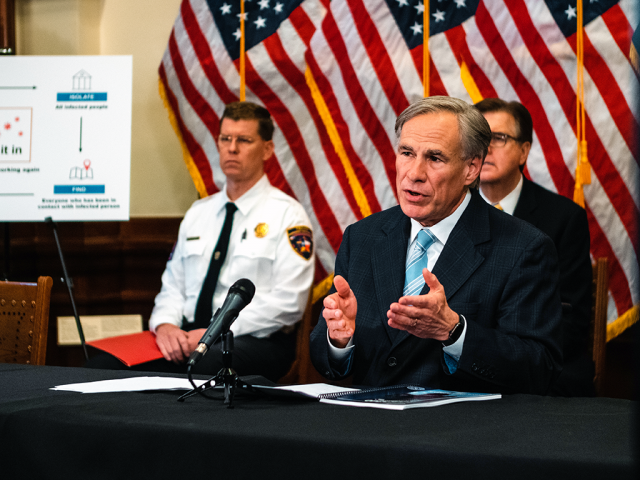
Governor Greg Abbott today announced the first phase of the State of Texas' ongoing plan to safely and strategically open Texas while minimizing the spread of COVID-19. Under Phase I, certain services and activities are allowed to open with limited occupancy, and the Texas Department of State Health Services (DSHS) is issuing minimum standard health protocols for all businesses and individuals to follow. The Governor also outlined special guidance for Texans over 65 and detailed a comprehensive mitigation plan for nursing homes in Texas. The Governor also announced a statewide testing and tracing program developed by DSHS that will help public health officials quickly identify and test Texans who contract COVID-19 and mitigate further spread of the virus.
The Governor's announcement is accompanied by Texans Helping Texans: The Governor's Report to Open Texas. This detailed report, available on the strike force website, helps Texans understand phase one by outlining the new protocols, guidance, and recommendations. The report also includes a series of Open Texas Checklists that outline DSHS' minimum standard health protocols for all Texans.
"This strategic approach to opening the state of Texas prioritizes the health and safety of our communities and follows the guidelines laid out by our team of medical experts," said Governor Abbott. "Now more than ever, Texans must remain committed to safe distancing practices that reduce the spread of COVID-19, and we must continue to rely on doctors and data to provide us with the safest strategies to restore Texans' livelihoods. We must also focus on protecting the most vulnerable Texans from exposure to COVID-19. If we remain focused on protecting the lives of our fellow Texans, we can continue to open the Lone Star State."
By way of Executive Order (GA-18), all retail stores, restaurants, movie theaters, and malls are permitted to reopen on Friday, May 1. These services must limit their capacity to 25% of their listed occupancy. Within shopping malls, the food-court dining areas, play areas, and interactive displays and settings must remain closed.
All museums and libraries may open under the same 25% occupancy limitation, but interactive areas of museums must remain closed. State libraries and museums will open by May 1, and local public museums and libraries may reopen only if permitted by the local government. Single-person offices may reopen as well.
Churches and places of worship remain open. Outdoor sports are allowed to resume so long as no more than four participants are playing together at one time. Certain social distancing practices must also be followed. Local government operations, including county and municipal government operations relating to permitting, recordation, and document-filing services, may reopen as determined by the local government.
Essential services such as farmers and ranchers, grocery and drug stores, banks, and gas stations will continue to operate. Public swimming pools, bars, gyms, cosmetology salons, massage establishments, interactive amusement venues, such as bowling alleys and video arcades, and tattoo and piercing studios will remain closed through Phase I. Nursing homes, state supported living centers, assisted living facilities, and long-term care facilities must remain closed to visitors unless to provide critical assistance.
The Governor also established increased occupancy protocols for certain counties with five or fewer laboratory confirmed cases of COVID-19. Those counties may, on an individualized basis, increase occupancy limits to up to 50% for restaurants, retail, shopping malls, museums and libraries, and movie theaters if they meet certain criteria. The county judge must certify and affirm to DSHS that the following standards have been investigated and confirmed to be met:
Phase I will begin Friday May 1 and continue until at least May 18. The Governor will continue to evaluate next steps for the state.
The Governor's Report to Open Texas also outlines a long-term comprehensive mitigation plan for nursing homes in Texas. Eight recommendations have been developed by HHSC to help mitigate the further spread of COVID-19 and decrease the risk of infection in these facilities. A summary of the recommendations is below, and full recommendations are in the Governor's report beginning on page 9:
During the press conference, the Governor also announced a new statewide testing and contact tracing program. Developed and implemented by DSHS, this program will help identify individuals who have contracted COVID-19 and those who may need to quarantine or be tested due to potential exposure. This phased implementation will allow Texans to box in the virus and slow, or even stop, further spread. Phase I of the tracing program has been completed, and Phase II begins today. Phase III begins May 11. More details about the contact tracing program are available in the Governor's Report to Open Texas beginning on page 16.
Governor Abbott today also relaxed certain restrictions related to health care professionals and issued amended requirements related to hospital capacity. Under an Executive Order (GA-19) issued today:
Additionally, the Governor issued an Executive Order (GA-20) to eliminate the mandatory 14-day quarantine period for individuals traveling from Louisiana. Under GA-20, the mandated 14-day quarantine for travelers from the following areas remains in place: California; Connecticut; New York; New Jersey; Washington; Atlanta, Georgia; Chicago, Illinois; Detroit, Michigan, and Miami, Florida.
View the Governor's Executive Orders issued today:
